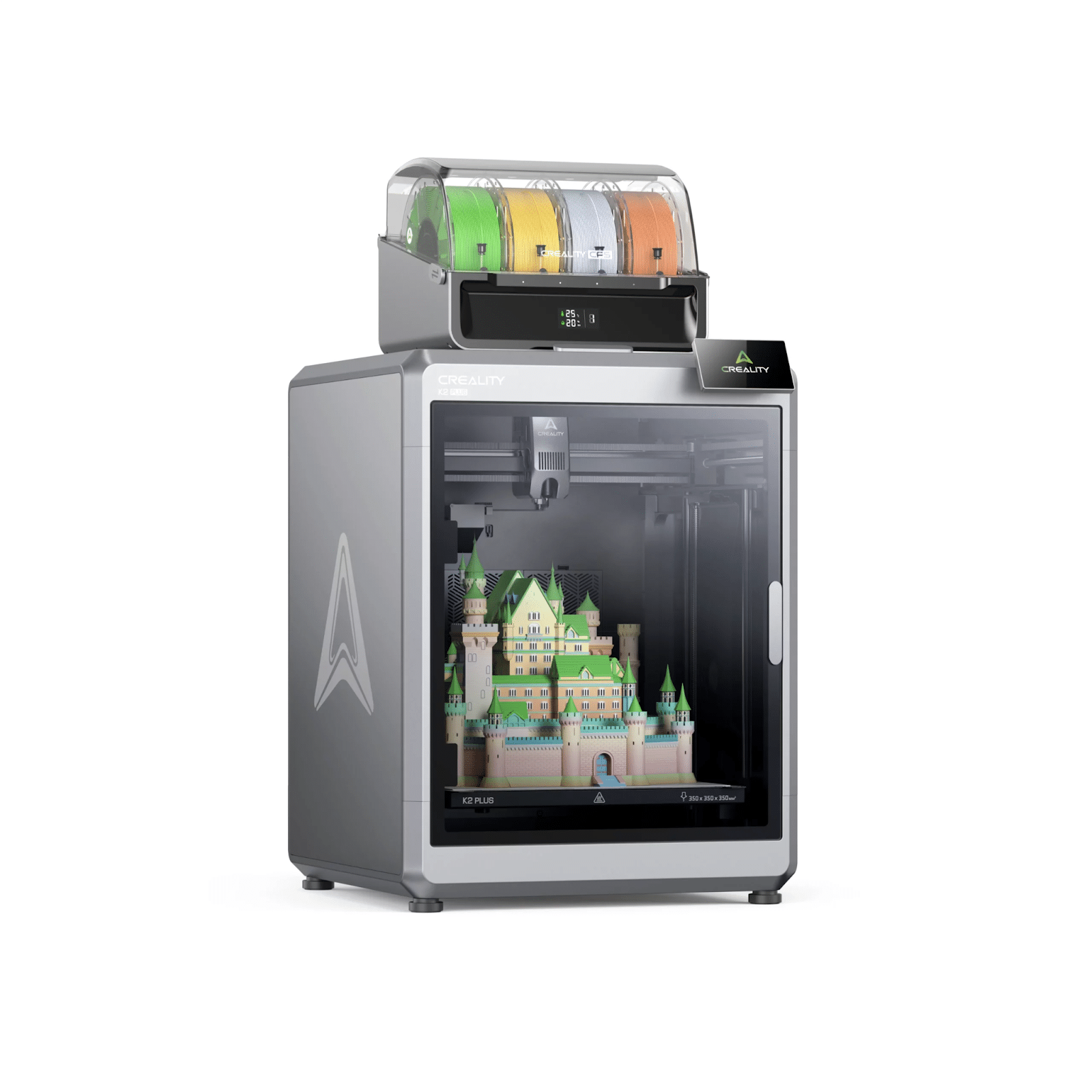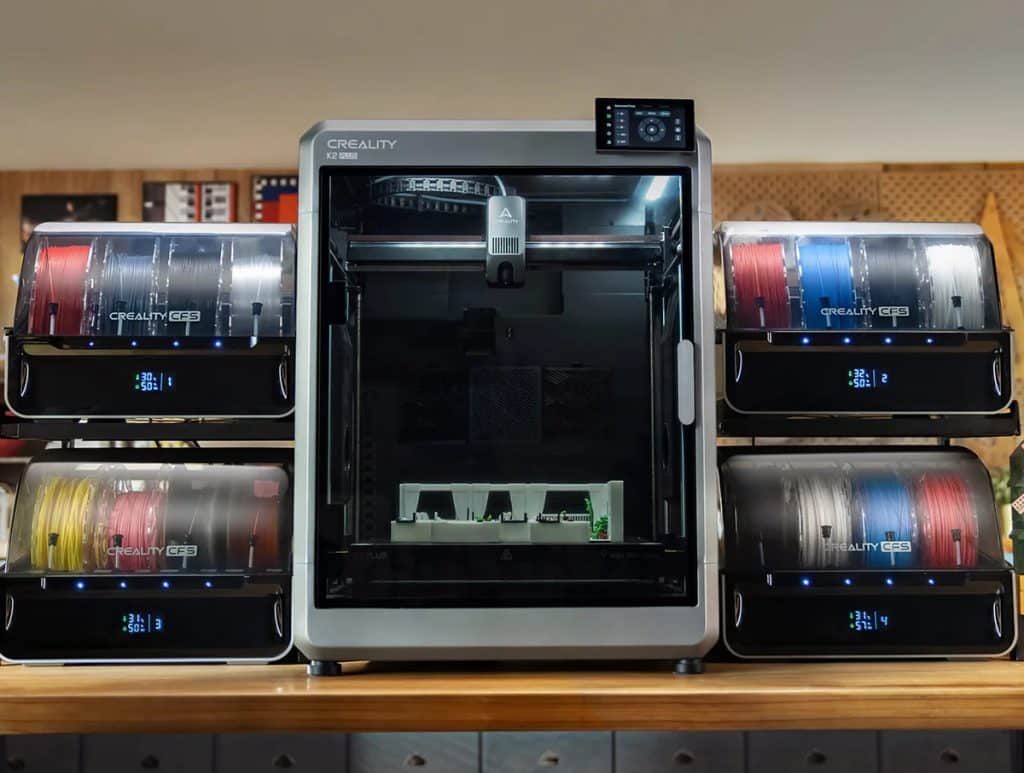3D printing has outgrown single-color and single-material manufacturing. In 2025, users expect printers to produce vibrant, intricate, and fully functional parts without additional assembly or painting. Now, the top multi-material and multicolor setups help educators, designers, and engineers quickly develop and experiment with ideas. In this evolution, Creality’s CFS (Color Filament System) ecosystem allows perfect filament management and incorporation. This makes innovative 3D printing further attainable for both experts and hobbyists.
What Is the CFS Ecosystem and How Does It Work?
The CFS ecosystem exemplifies the Color Filament System, created by Creality to facilitate and increase multicolor and multi-material printing. It works as an external system that links straightway to appropriate printers like the Creality K2 Plus, integrating several filaments in one print task.
Core Functions
- Intelligent Filament Switching: The CFS mechanically shifts among up to four spools throughout printing. It helps avoid hand-operated filament exchanges and keeps constant output.
- AI-Driven Coordination: Integral algorithms observe filament movement, lower stringing, and reduce debris through material or color shifts.
- Modular Spools: Users can conveniently fill or change filaments, even if it is typical PLA, adaptable TPU, or PETG. The spools encircle the area, confirming seamless feeding.
Multicolor vs. Multi-Material Capabilities
The CFS ecosystem approves both multi-material and multicolor systems.
- Multicolor Printing: Now print with different colors of the same filament kind; best for figures, toys, lithophanes, and branding models.
- Multi-Material Printing: Fuse materials alongside diverse characteristics. For instance, TPU for adjustable joints and PLA for hard sections in a single model. This extends usage scenarios in practical prototyping, product testing, and robotics.
Why Multicolor and Multi-Material Printing Matters
Multi-material and multicolor printing evolves the way people outline, try out, and showcase their concepts. Rather than printing a simple thing and painting it afterwards, you can develop models with proper colors right from the beginning.
This is time-saving and offers faultless outcomes. Multicolor prints turn lessons further correlative for educators, students can manage DNA prototypes or geography maps with different, thriving parts that help with understanding.
Also, engineering uses profit. Blending flexible and stiff filaments in a single print allows designers to experiment with working components that act more like actual items.
A joint printed with the two PLA (hard) and TPU (flexible) can affect the final output while prototyping. This type of capability quickens the product design process and lowers prices.
Moreover, real-world jobs represent the worth of this ability. Cosplayers utilize multicolor printing to generate elaborate props without painting. Product developers create market-ready models with sophisticated looks.
Meet the Hardware: Creality K2 Plus and CFS Combo

The Creality K2 Plus functions perfectly with the CFS unit to make a multi-material and multicolor printing approachable. This combination provides a comprehensive formula for users seeking the two creativity and speed in their 3D prints.
Key Features of the Creality K2 Plus
- Swift Printing: The K2 Plus works at paces much higher than normal consumer printers, minimizing downtime for complicated or big tasks.
- AI Camera for Error Detection: A fitted camera keeps track of prints instantly, capturing breakdowns before they misuse material or time.
- Smart Leveling and Slicing Integration: Slicing software and automatic bed leveling combination guarantee decent initial layers and continuous print quality.
Easy Integration with CFS
The CFS links straight to the K2 Plus, so users can set up the system without technical expertise or intricate calibration.
When combined, the CFS and K2 Plus function together to control filament shifts, purge orders, and print requirements. This fusion is like a bridge between engineering accuracy and artistic freedom.
Supported Materials and Color Filament Compatibility
The CFS ecosystem operates with commonly utilized 3d printing materials. The most famous is PLA, as it prints conveniently and creates constant outcomes.
PETG introduces chemical resistance and longevity, making it appropriate for useful parts. That said, TPU brings resilience, permitting flexible designs such as hinges or cell phone cases.
The CFS can manage multi-material tasks by shifting among diverse filaments in just one print. A prototype can blend stiff PLA and adaptable TPU in one run, approving components that twist in a few regions while staying strong in others.
Advanced filament detection confirms that the spools fill accurately. Sensors monitor the filament situation and pause prints mechanically when a spool ends.
Also, humidity management is included in the storage setup, aiding in maintaining material performance in longer tasks.
How to Get Started with CFS Multicolor Printing?
To start off with CFS printing, follow these steps:
- Prepare the model in slicing software: Utilize Creality Print or a different suitable slicer and allocate materials and colors to particular components of the model.
- Fill and allot filaments in the CFS: Add up to four spools, verify detection, and allocate them in the slicer profile.
- Rearrange the printer: Operate the determined calibration procedure on the K2 Plus. This setup regulates nozzle temperature, bed leveling, and filament movement.
- Preview the print assignment: Inspect the slicer preview to confirm that the color alters and material sequence meet expectations.
- Begin the print: The CFS and printer automatically align to handle shifting and purging while printing.
Cloud-enabled clarifies the workflow more. Now, you can get files ready remotely and give them straight to the printer.
Tips for Getting Vibrant, Flawless Multicolor Prints
Exemplary results count on thoughtful preparation. Begin with prototypes that assist multi-material or multicolor slicing.
Good slicers like Creality Print empower users to allocate diverse filaments and colors to specific segments of a design. Walk through every task before printing to verify changes.
Further tips enhance stability:
- Position purge towers deliberately to keep perfect filament switches.
- Modify temperature and withdrawal settings to avoid mixing.
- Maintain filaments dry through desiccant packs and sealed stocking.
- Do trial printing to inspect calibration.
- Cleanse nozzles routinely to prevent blockages.
- Utilize the AI camera to capture faults timely.
Final Thoughts
Multi-material and multicolor printing no more demands industrial tools. The Creality CFS ecosystem, combined with the K2 Plus, provides newbies and experts a way in to equipment that increases artistic and functional opportunities. Intricate models, thriving prototypes, and composite designs can be created in one print cycle.
